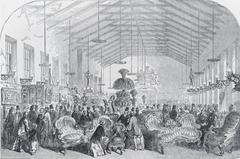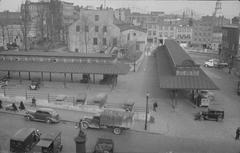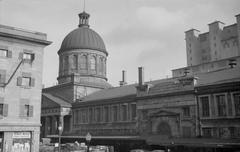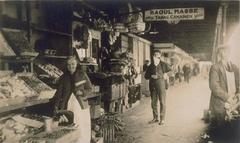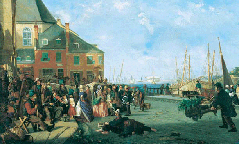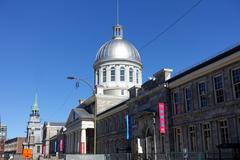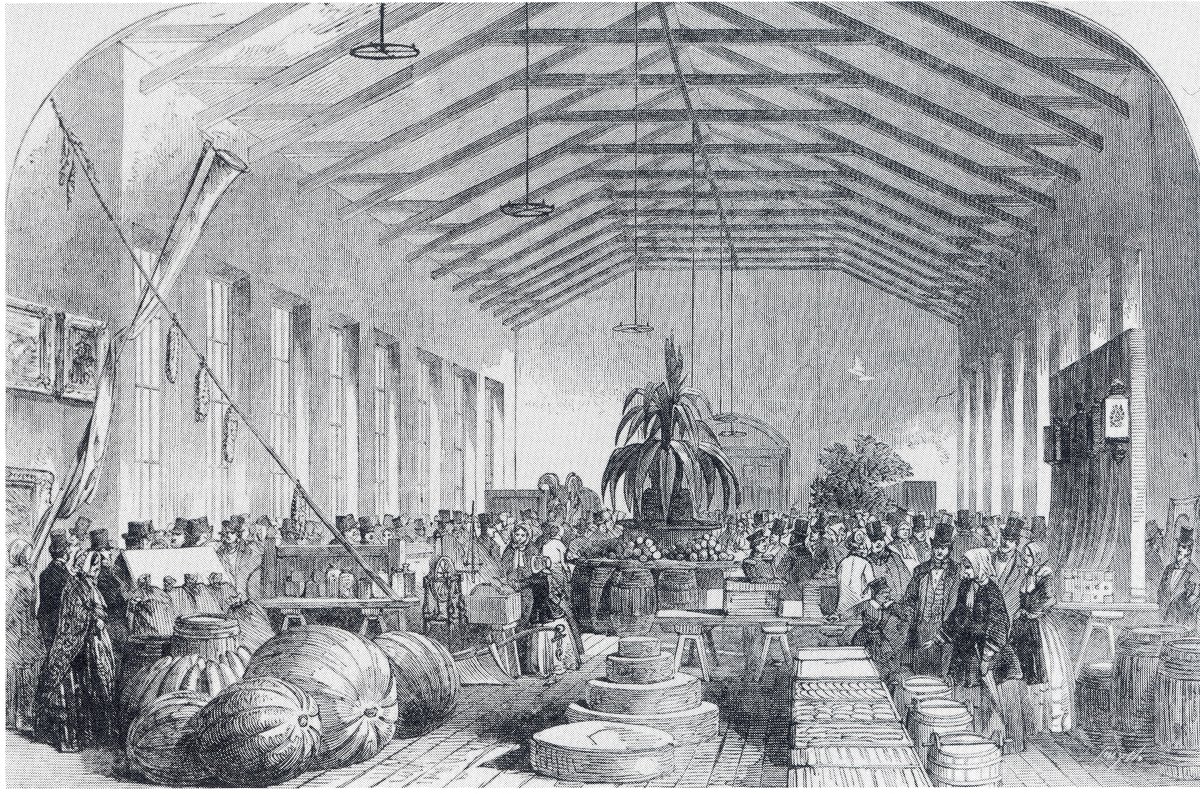
Visiting Hours, Tickets, and Historical Sites: A Comprehensive Guide to Marché Bonsecours, Montreal
Date: 18/07/2024
Introduction
Marché Bonsecours stands as a beacon of Montreal’s rich history, cultural vitality, and architectural splendor. Nestled in the heart of Old Montreal, this iconic market hall has evolved through the decades, reflecting the city’s dynamic spirit and resilience. Initially inaugurated in 1847, Marché Bonsecours was designed by architect William Footner with a neo-classical style that drew inspiration from British customs houses (source). Over the years, it has transitioned from a bustling public market to a temporary municipal seat and, eventually, to a cultural hub that attracts both locals and tourists. Today, Marché Bonsecours is a dynamic space that houses boutiques, art galleries, restaurants, and event venues, making it a must-visit destination for anyone exploring Montreal. This comprehensive guide aims to provide you with all the essential information you need for an enriching visit, including historical insights, practical tips, and recommendations for nearby attractions.
Table of Contents
- Marché Bonsecours - Visiting Hours, History, and Tickets for Montreal’s Historic Market
- Early Years - A Multifaceted Public Space (1847-1878)
- From Market to Municipal Seat - A Temporary Home (1878-1922)
- Decline and Uncertain Future - A Period of Transition (1922-1963)
- A New Lease on Life - Rebirth as a Cultural Hub (1964-Present)
- Visiting Marché Bonsecours - Practical Information
- Unique Aspects and Events
- The Marché Bonsecours Today - A Symbol of Resilience and Renewal
- FAQs
Marché Bonsecours - Visiting Hours, History, and Tickets for Montreal’s Historic Market
The Marché Bonsecours, a prominent landmark in Old Montreal, boasts a rich and fascinating history that reflects the city’s evolution. Its story is one of transformation, adaptation, and enduring spirit.
Early Years - A Multifaceted Public Space (1847-1878)
Inaugurated in 1847, the Marché Bonsecours was initially conceived as a public market hall, a stark contrast to its current incarnation. Designed by architect William Footner, the building’s neo-classical design, inspired by British customs houses, was considered quite grand for its time.
The market quickly became the heart of Montreal’s commercial activity, bustling with vendors selling fresh produce, meats, and fish. However, its purpose extended beyond commerce. The Marché Bonsecours also served as a venue for public gatherings, exhibitions, and even political rallies.
One notable event was the reception of the Prince of Wales, later King Edward VII, in 1860. The market was lavishly decorated for the occasion, showcasing its versatility as a public space.
From Market to Municipal Seat - A Temporary Home (1878-1922)
A fire in 1872 ravaged the original Montreal City Hall, forcing the municipal government to seek a temporary home. The Marché Bonsecours, with its spacious interiors and central location, became the chosen site.
For the next 44 years, the building housed the city council chambers and administrative offices. This period saw significant decisions being made within its walls, shaping the development of Montreal.
Despite its administrative role, the market continued to operate on a smaller scale, demonstrating its enduring connection to the city’s commercial life.
Decline and Uncertain Future - A Period of Transition (1922-1963)
By the early 20th century, the Marché Bonsecours faced a period of decline. The construction of larger, more modern market halls in other parts of the city drew vendors and shoppers away.
After the city government relocated to its new City Hall in 1922, the building’s future became uncertain. It served various purposes, including storage space and even a theatre, but none of these uses were able to restore its former glory.
A New Lease on Life - Rebirth as a Cultural Hub (1964-Present)
The 1960s marked a turning point for the Marché Bonsecours. Recognizing its historical and architectural significance, the city of Montreal undertook a major restoration project. The building was designated as a National Historic Site of Canada in 1983, further cementing its importance.
Reopened in 1964, the Marché Bonsecours embarked on a new chapter as a vibrant cultural hub. It became home to art galleries, boutiques, exhibition spaces, and restaurants, attracting locals and tourists alike.
The building’s grand hall, once the site of bustling market activity and later city council debates, was transformed into a stunning venue for events, conferences, and weddings.
Visiting Marché Bonsecours - Practical Information
Visiting Hours - The Marché Bonsecours is open daily from 10:00 AM to 6:00 PM, though hours may vary during holidays and special events. It is advisable to check the official website for the most current visiting hours.
Tickets - Entrance to the Marché Bonsecours is free of charge. However, some special exhibitions and events may require tickets. Information on tickets can be found on the official Marché Bonsecours website.
Travel Tips - Marché Bonsecours is easily accessible by public transportation. The nearest metro station is Champ-de-Mars. Parking is available nearby, but spaces can be limited, especially during peak tourist season. Plan your visit accordingly.
Nearby Attractions - While visiting Marché Bonsecours, consider exploring other historical sites in Old Montreal, such as the Notre-Dame Basilica, the Old Port, and the Pointe-à-Callière Museum.
Accessibility - Marché Bonsecours is wheelchair accessible, with ramps and elevators available for use. For specific accessibility needs, it is recommended to contact the venue in advance.
Unique Aspects and Events
Marché Bonsecours hosts a variety of special events throughout the year, including art exhibitions, craft fairs, and cultural festivals. Guided tours are available, offering deeper insights into the building’s history and architecture. The venue is also a popular spot for photography, with its stunning façade and grand interiors providing a picturesque backdrop.
The Marché Bonsecours Today - A Symbol of Resilience and Renewal
Today, the Marché Bonsecours stands as a testament to Montreal’s rich history and its ability to adapt and evolve. It is a place where the past seamlessly blends with the present, offering a unique experience for visitors.
Whether browsing through the eclectic mix of shops, admiring the architectural grandeur, or simply soaking in the lively atmosphere, a visit to the Marché Bonsecours is a journey through time, reflecting the spirit of Montreal itself.
FAQs
Q: What are the visiting hours for Marché Bonsecours? A: Marché Bonsecours is open daily from 10:00 AM to 6:00 PM. Check the official website for any changes in hours.
Q: Is there an entrance fee for Marché Bonsecours? A: Entrance to the building is free, but some special exhibitions and events may require tickets.
Q: How do I get to Marché Bonsecours? A: The nearest metro station is Champ-de-Mars, and parking is available nearby.
Q: Is Marché Bonsecours wheelchair accessible? A: Yes, the building is wheelchair accessible with ramps and elevators.
Q: Are guided tours available at Marché Bonsecours? A: Yes, guided tours are available and provide deeper insights into the building’s history and architecture.
Call to Action
Plan your visit to the iconic Marché Bonsecours today and immerse yourself in Montreal’s rich history. For more information on visiting hours, tickets, and events, check out the official Marché Bonsecours website. Don’t forget to download our mobile app Audiala for more travel tips and updates, and follow us on social media for the latest news and events.
Conclusion
Marché Bonsecours is more than just a historic market; it is a living testament to Montreal’s ability to adapt and thrive through changing times. From its early days as a bustling market hall to its current status as a cultural and commercial hub, the market encapsulates the essence of Montreal’s rich heritage and modern vibrancy. Whether you’re interested in exploring the unique boutiques, savoring culinary delights, or simply soaking in the historical ambiance, Marché Bonsecours offers a multifaceted experience that caters to a diverse range of interests. Be sure to check out nearby attractions like the Notre-Dame Basilica and the Old Port to make the most of your visit. For more detailed information, including visiting hours and event schedules, visit the official Marché Bonsecours website and stay updated through their social media channels.

